In the first half of this century, perfin stamps were very much used in use by private companies. These companies were looking for some deterrent to minimize the personal use of company purchased stamps by employees. This idea was not particularly new. The first perfin authorization was given by the British postal authority in March, 1868. It was felt that if the company could somehow "mark" their stamps with some distinguishing sign, employees would be hesitant to take them. The marking method which was allowed by the postal authorities was the perforation of postage stamps with the distinctive marks (initials or other) of the firm using them. The designs of the perforated marks were for identification, and not for advertising.
In Canada, general permission for the use of perfins was given in 1895 and the first ones appeared in 1889, but it was not until 1910 that the Post Office ordered that the perforations must be approved prior to their use, and that the perforations not exceed specified limits.

In 1955, when the Canadian Boy Scouts Stamp was issued for the 8th World Jamboree at Niagara-On-The-Lake, there were over 50 approved perforations by over 35 different companies. The difference in numbers was due to some of the larger firms having slightly different perforations marks to distinguish their multiple office across the country.
However, that didn't mean that there are that many examples of perfins on the Scout issue. Some of the (one time) approvals were quite old and the firm had stopped using perfins long before. Many firms were then using meter cancels, with no need to go out and purchase stamps then pass them through a perforating machine. As well, many firms had a practice of just purchasing the definitive stamps, and not the commemorative ones. Thus it is very difficult to find records of which another example, it gets added to the list. The ones currently identified include:
- Bell Telephone [BT]
- Canadian Broadcasting Corporation [CBC]*
- Canadian General Electric [C/GE]
- Canadian National Railways [CNR]
- Canadian Pacific Railways [CPR]
- International Harvester of Canada [C(HI)]
- New York Life Insurance [NYL]
- Quebec Liquor Commission [Q/CLQ/C]*
- William Wrigley Jr. Co. [WW/JR]
All of the above, except those flagged with an [*], had multiple versions of the basic designed for various offices across the country (but not all offices might have used the Scout stamp). The most common varieties found today include Bell Telephone, Canadian National Railways, and New York Life.
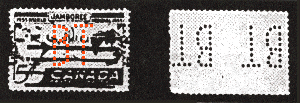
Bell Telephone: Montreal [B15]
The Bell Telephone perfin [B15] is show in Figure 1. This example is from the Montreal office, and was used from 1942 through 1957. An earlier version, [B14] had a slight difference in the holes in the middle of the 'B'.
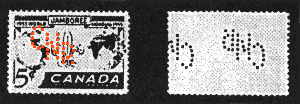
Canadian National Railways: Montreal [C46]
Figure 2 shows the Canadian Railways perfin [C46] from their Montreal office. Many offices had small differences in the relative size and/or positioning of the letters in the 'CNR' designation.
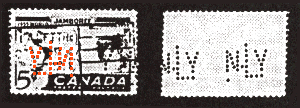
New York Life: Montreal (N9)
Two examples of the New York Life perfin are shown in Figures 3 and 4. Figure 3 is from the Montreal office [N9], with a hole between the 'N' and 'L' in a low position. The perfin from the Toronto office has the same hole midway up the letters, and two holes at the bottom of the 'Y'. New York Life had probably the largest number of variations among their offices, each one distinguishable by minor variations in the hole positions. Note also, that the reverse side in Figure 3 shows mirror image lettering, indicating the mailroom clerk had placed the sheet of stamps upside down in the perforating machine. Normally, the sheets were placed in the machine so that the letters could be read correctly from the front of the stamps.
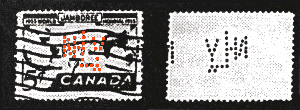
New York Life: Toronto (N14)
It is also interesting to note that some Canadian firms had their perforating machines in some of their USA branch offices. For example, New York Life Insurance of Canada had a branch in Buffalo which used a perfin [N22] from 1932 to 1955 on USA stamps. That fact raises an interesting question. It is possible that they might have had occasion to use the 1950 US Scout stamp in any of their machines? Though I have never seen an example of such, it is not unreasonable to believe such an item may exist. The possibility of a new discovery is part of the enjoyment of perfin collecting.
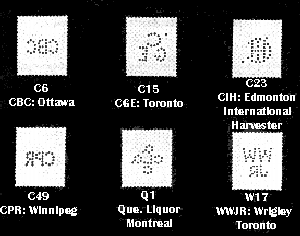
The letters of other firms who perforated the Scout stamp are shown in Figure 5 above.
Perfin stamps are extremely difficult to find these days, especially if you limit your collection to a topical commemorative stamp like the Boy Scout issue of 1955. It is even more difficult to find one used on cover. It is the hunt, however, that makes this hobby interesting, and the satisfaction of finding an example is bliss! Perfins have become an excellent sideline adventure to standard Scout philately.
For more information:
Most of this data, including the PERFIN numbers is taken from the
booklet "Canadian Stamps with Perforated Initials"
Fourth Edition, which was prepared by the BNAPS Perfin Study
Group, edited by J.C. Johnson and G. Tomasson. Published by
the Unitrade Press of Toronto.
SOSSI Journal, Volume XXXXVII, Number 2, March-April 1998
Modified by Keith Larson


